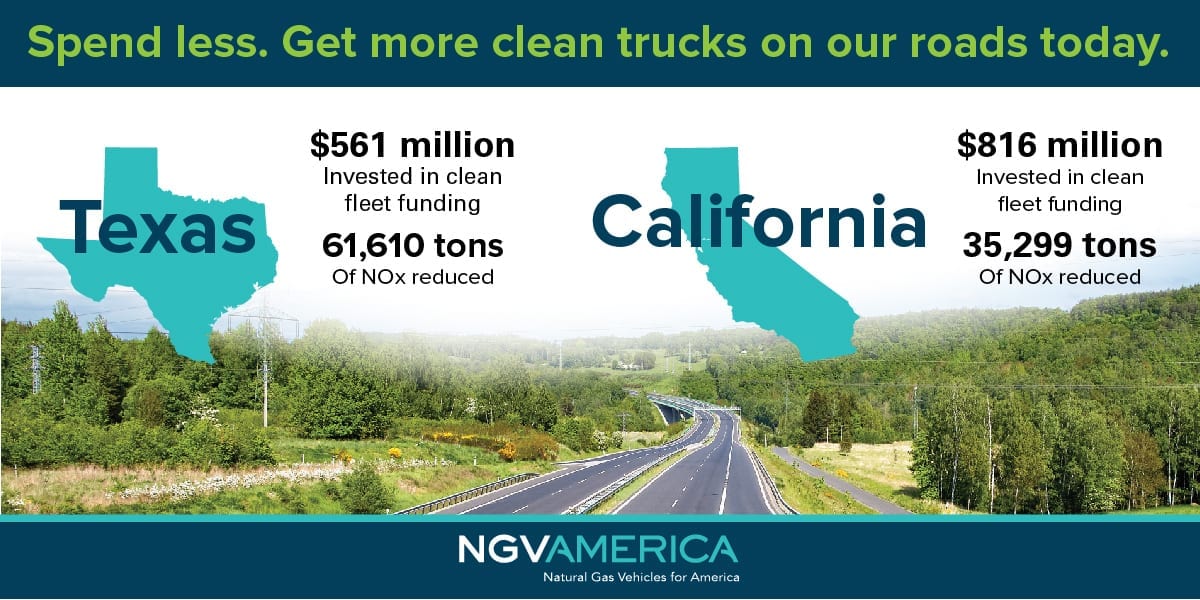Public entities across the United States – federal, state, and local – are investing hundreds of millions of dollars collected from taxpayers, ratepayers, and end users to transition to a cleaner transportation future.
That investment is important since some 50 percent of all criteria pollutants and 28 percent of all greenhouse gas (GHG) emissions come from the sector. But are governments investing those precious public resources wisely, guided by actual outcomes and achievable today, real-world results?
Public entities are investing hundreds of millions of dollars in cleaner transportation, but are they investing wisely?
Understanding Outcomes: Texas vs. California
NGVAmerica spent the last several months poring through fifteen years of public data obtained from the Texas Commission on Environmental Quality (TXCEQ) and the California Air Resources Board (CARB) and California Energy Commission (CEC) to see how two different states with very different outlooks invest their cleaner fleet subsidy programs. The results are quite striking.
From 2005 to 2019, the State of Texas spent $561 million in public resources to assist in the transition to cleaner vehicle technologies. During the same period, the State of California spent $816 million, or 46 percent more. However, in terms of reducing harmful criteria pollutants to improve air quality, California achieved only a 35,229-ton reduction in NOx emissions despite its increased investment while Texas tallied reductions of 61,610 tons of NOx. Effectively, California regulators spent 46 percent more public money while accomplishing 43 percent less than Texas.
NGVAmerica compared fifteen years of public data from TXCEQ, CARB and CEC to see how they invested in their clean fleet subsidy programs.
California focused its funding on medium- and heavy-duty battery electric vehicle test projects. In contrast, Texas focused on replacing older, dirtier medium- and heavy-duty diesel trucks with a variety of new, cleaner, CNG, LNG, LPG, diesel, and diesel-hybrid alternatives.
This analysis presents a stark reality for policymakers to consider. Compared to California’s ZEV-only focus, the Texas approach results in less money spent, deploys more clean heavy-duty trucks and buses on the road, and achieves greater emissions reductions.
Texas Reduced NOx Even as Population Grew
Since 2000, Texas has reduced its NOx emissions by 69 percent while its total population has increased by 35 percent. Meanwhile, from 2006 to 2013, California reported annual NOx emissions of 160,000 tons per year. Since that time – and despite its increased ZEV-focused investment – California’s annual emissions have increased to about 175,000 tons per year.
Texas continues its clean air achievement by supporting vehicle choice and an “all of the above” approach to alternative fuel vehicle technologies. As Texas begins to add renewable natural gas (RNG), or biomethane, derived from above ground sources to its natural gas vehicle investments, Texas is creating actual carbon-free fleet solutions today.
Compared to California’s ZEV-only focus, Texas spent less money and achieved greater emissions reductions.
While supportive of increased RNG production capacity, California is moving to limit the best use of this captured biomethane – as a transportation fuel – by supporting only ZEV purchases that require massive amounts of public funding to subsidize.
New Jersey Refuse
But California is not the only state considering single technology mandates for specific heavy-duty fleets, including transit, refuse, and freight delivery.
Using New Jersey as a case study, NGVAmerica analyzed the costs and impact of transitioning that state’s entire 10,000 refuse truck fleet from diesel to both natural gas and battery electric… and the results might be surprising to some.
Not only did natural gas vehicle (NGV) refuse trucks – fueled by RNG – outperform their electric counterparts when it comes to total NOx emission reductions well-to-wheel, they reduced more harmful CO2 equivalent emissions in total than the battery electric alternative. In terms of criteria pollutants, the NGV fleet reduced 14,000 tons of NOx compared to only 9,700 tons for the battery fleet. In terms of GHGs, NGVs reduced 10.6 million tons of CO2. The electric fleet only achieved a 9.2 million-ton GHG reduction.
Furthermore, the cost difference to upgrade New Jersey’s 10,000 truck fleet from diesel to cleaner technologies was substantial – an estimated $350 million in incremental costs for NGVs while a complete battery electric fleet conversion could cost between $3.5 and $4.2 billion.
In New Jersey, refuse trucks fueled by RNG outperform EV counterparts in NOx reductions.
RNG Fueled Vehicles Reduce NOx and GHG Emissions
The takeaway is clear. Not only do natural gas vehicles fueled by RNG outperform battery electric alternatives in terms of impactful NOx and GHG reductions, they are more cost effective and make far better investments of public tax dollars.
This transition in New Jersey to cleaner natural gas refuse fleets is already underway, with three-quarters of all New Jersey counties deploying natural gas refuse trucks already. Over 550 natural gas trucks are deployed in New Jersey today, serving 16 of the 21 counties in the state. To date, communities and businesses in New Jersey have invested more than $200 million in natural gas trucks and fueling infrastructure. We should build on that.
NGVs fueled with RNG are the most immediate and cost-effective carbon-free transportation solution available now. According to CARB’s own data, RNG holds the lowest carbon intensity of any on-road vehicle fuel, including fully renewable electric.
Now more than ever, communities need affordable, available, and easily scalable clean transportation solutions that address pollution while ensuring that public funding is put to its best use. Natural gas vehicles fueled by RNG is the best carbon-free, zero now solution.
Full access to these study documents is available in NGVAmerica’s online Resource Center at: Which Road to Take – TX vs. CA Investments, and Cleaning the Air & Decarbonizing NJ with CNG Refuse Trucks.


